Category: Business

A Dirty Tip to Make Your Social Media Content More Shareable
Tire turd (noun): Wad of snow, ice, salt and gravel that piles up behind each vehicle tire in the winter. Removable only with explosives. #Iowa #winteriniowa
That’s a recent Facebook post I created when was in Red Oak, Iowa, this week, working on a newsletter for United Farmers Cooperative. When I stopped at the grain elevator, I saw this tire turd on my car. I decided to share it on my personal Facebook page. This silly post apparently struck a chord, because it has been liked 159 times, generated 23 comments and has been shared 17 times. Crazy!
This reminds me of one of the principles I teach in my storytelling classes. Shareability is a key to the most successful social posts.
People don’t just share any old content. Facebook reports that 0.5% of those who see a Facebook post share it. Of all the content links the average Twitter user receives, the re-tweet ratio is 1:318, according to one of my favorite books, “The Content Code,” by Mark Schaeffer.
Research sponsored by the New York Times found that people share content to:
• To be useful, since the info. is practical or timely
• To define themselves to others (look smarter, funnier, more relevant)
• To strengthen relationships with others
• Get the word out about causes, brands, events, etc. they care about
Think about the last time you shared something. What motivated you to do this?
How could you frame your stories and information to make your content more shareable?
Want more?
Thanks for stopping by. I invite you to read more of my blog posts if you value intriguing Iowa stories and history, along with Iowa food, agriculture updates, recipes and tips to make you a better communicator.
If you like what you see and want to be notified when I post new stories, be sure to click on the “subscribe to blog updates/newsletter” button at the top of this page, or click here. Feel free to share this with friends and colleagues who might be interested, too.
Also, if you or someone you know could use my writing services (I’m not only Iowa’s storyteller, but a professionally-trained journalist with 20 years of experience), let’s talk. I work with businesses and organizations within Iowa and across the country to unleash the power of great storytelling to define their brand and connect with their audience through clear, compelling blog posts, articles, news releases, feature stories, newsletter articles, social media, video scripts, and photography. Learn more at www.darcymaulsby.com, or e-mail me at yettergirl@yahoo.com.
If you’re hungry for more stories of Iowa history, check out my top-selling “Culinary History of Iowa: Sweet Corn, Pork Tenderloins, Maid-Rites and More” book from The History Press. Also take a look at my latest book, “Dallas County,” and my Calhoun County” book from Arcadia Publishing. Both are filled with vintage photos and compelling stories that showcase he history of small-town and rural Iowa. Order your signed copies today! Iowa postcards are available in my online store, too.
Let’s stay in touch. I’m at darcy@darcymaulsby.com, and yettergirl@yahoo.com.
Talk to you soon!
Darcy
@Copyright 2019 Darcy Maulsby & Co. Blog posts may only be reprinted with permission from Darcy Maulsby.

Stop Rumors Before They Ruin Your Brand
Seriously–how does this stuff get started?
Like many of you, one of my goals for 2019 has been to focus on wellness, and that includes more exercise. Since options are limited here in snowy, cold Iowa in the winter, I’m glad there’s an indoor swimming pool nearby that’s open to the public a few hours a day.
I was swimming with some of my friends this morning, and one of them asked, “Have you sent that email yet?” I didn’t know what she was talking about, and she said she’s trying to encourage people who use the pool to let the facility’s administrator let know how much the community values the pool and how we don’t want it to close.
Turns out there’s a rumor swirling around that the cost of maintaining the pool might be prompting people in charge of the facility to close the pool. Distressing information, indeed.
I was glad when another one of my friends (one who works at the facility) stopped by to said hi while I was in the water. I asked if the talk about closing the pool was true.
“Where did you hear that?”
We told her the rumor was going around town. “No, this pool is important,” she said. “We have no plans to close it down.”
Not only was I relieved, but I started thinking about another conversation I had at the pool this morning. One of my friends brought up the name of the administrator of a large organization in town–but she admitted she wasn’t sure what the lady’s name was. Smith? Jones? Not sure.
All of us in the pool agreed that we knew little about this person. We also agreed how important it is for an organization (and those who lead it) to remain visible and keep the lines of communication open.
I wonder how many rumors, snippets of misinformation and flat-out lies could be countered effectively if people–especially business leaders–would stay in touch regularly with employees, customers, prospects, donors, the media and other key audiences. I’m not talking about a once-and-done approach, either.
In my experience, the best approach involves an ongoing commitment to sharing true stories well told through blog posts, e-newsletters, magazine articles, social media posts, videos and more) to add value for your audience. Along the way, you establish yourself as a trusted leader.
It’s an approach worth considering, especially in a world where a lie told often enough tends to become the truth.
Want more?
Thanks for stopping by. I invite you to read more of my blog posts if you value intriguing Iowa stories and history, along with Iowa food, agriculture updates, recipes and tips to make you a better communicator.
If you like what you see and want to be notified when I post new stories, be sure to click on the “subscribe to blog updates/newsletter” button at the top of this page, or click here. Feel free to share this with friends and colleagues who might be interested, too.
Also, if you or someone you know could use my writing services (I’m not only Iowa’s storyteller, but a professionally-trained journalist with 20 years of experience), let’s talk. I work with businesses and organizations within Iowa and across the country to unleash the power of great storytelling to define their brand and connect with their audience through clear, compelling blog posts, articles, news releases, feature stories, newsletter articles, social media, video scripts, and photography. Learn more at www.darcymaulsby.com, or e-mail me at yettergirl@yahoo.com.
If you’re hungry for more stories of Iowa history, check out my top-selling “Culinary History of Iowa: Sweet Corn, Pork Tenderloins, Maid-Rites and More” book from The History Press. Also take a look at my latest book, “Dallas County,” and my Calhoun County” book from Arcadia Publishing. Both are filled with vintage photos and compelling stories that showcase he history of small-town and rural Iowa. Order your signed copies today! Iowa postcards are available in my online store, too.
Let’s stay in touch. I’m at darcy@darcymaulsby.com, and yettergirl@yahoo.com.
Talk to you soon!
Darcy
@Copyright 2019 Darcy Maulsby & Co. Blog posts may only be reprinted with permission from Darcy Maulsby.

How to Tell Your Community’s Story—with Style!
Every community has a wealth of interesting stories to tell. What makes your town unique? More importantly, how can you share those stories to drive tourism, welcome new businesses and residents and put your community on the map in a whole new way?
I call it “story selling,” and it works.
I first discovered the power of a story to inspire action in 1998 when I was a full-time editor at the Iowa Farm Bureau Spokesman. I had the chance to write about something interesting close to my home area of Lake City and Yetter (“Everything’s Better in Yetter”—what a town motto!).
The first thing that popped into my mind? The Jake Burger at the Yetter Café.
Now, granted, this was a tasty, thick, juicy burger, but it’s like a lot of other beef burgers. No secret sauce, wild ingredients or anything like that. What made the story come alive, though, was the restaurant owner.
Merlin “Jake” Janssen is one of those local characters who has done a little bit of everything in his life, from trucking to cooking. When he opened a café in an early 1900s-era two story clapboard home on Plum Street in Yetter, his Yetter Café soon developed a loyal following, from the employees at the ag co-op across the railroad tracks to area farmers to locals who wanted to see what all the fuss was about.
Not one to stick with boring names like “hamburger” or “cheeseburger,” Jake was a marketing wizard of sorts who named his most famous creation the Jake Burger. My story set the stage with all the sensory details, from the cozy feel of the tiny dining room to the savory aroma wafting from the kitchen as Jake fried the burgers. I also shared some of Jake’s backstory along the way, showing what sparked his interest in the restaurant business (I’m a people person!” he exclaimed) and what it’s like to run a café in a town of 35 people.
I described how the Jake Burger came with all the trimmings, from lettuce to tomato to onion. I noted that each culinary creation was prepared by Jake himself. For added spice, I dished about tales of how each Jake Burger was always served with a hearty side of small talk and wise cracks.
After my story and a photo of Jake with his namesake burger ran in the Spokesman, I asked Jake if he got much feedback from that article. “I sure did,” he said. “One guy drove all the way from Nashua to just to try a Jake Burger. Can you believe that?”
To the casual observer, it might seem unbelievable that someone would drive more than 150 miles one way to tiny town to eat a Jake Burger. But that, my friends, is the power of story.
Why does a good story matter?
Imagine a world without stories. If you’re like me, you can listen to a few facts, but not many before you start tuning out. In this hectic, distracted world, true stories well told are incredibly powerful, since they:
- Capture people’s attention
- Propel you past the dreaded “sales pitch syndrome” and invite people to relax and listen
- Put facts in context and make them relevant to your audience
- Convey complex information in a way that’s easy to understand
- Add value
- Build trust
- Boost your competitive advantage
- Showcase the quality of life in your community (arts, entertainment, economic development and more)
- Inspire people to share your content
- Make your community more memorable
- Encourage new businesses to locate in your area
- Attract more grants and investment in your community
- Help existing businesses grow and retain quality employees
- Honor the community’s history
- Enhance community pride
- Attract new residents
- Create momentum that translates into economic development
What makes a good story?
The first step is to identify the people and places that make your community unique. Story ideas might come from the new business that came to town in the last few years, or they might be inspired by the factory that’s been in the community for generations.
Good stories can be found at the local cafe that offers foods inspired by the region, or they can reflect the unique public art project that graces your town square. Compelling stories might include the historic highway that runs through your town and how this influenced the town’s growth, or a great story might focus on a must-see item at the local museum run by dedicated volunteers.
Above all, unforgettable stories revolve around people. Always humanize your stories to help them resonate with your audience.
How do I tell a good story?
Here are some do’s and don’ts:
- Do train your brain to always be looking for potential stories you can share.
- Don’t just rattle off lists of facts or opinions (our town has 2,500 people, we have 20 businesses in town, we are a progressive community, etc.). This information is important, but it’s not a story.
- Do learn what defines a story. Some of the best stories take a problem/solution format, almost like a case study. In my hometown of Lake City, Iowa, I think of Opportunity Living, a home for handicapped people. In a nutshell, the story is a classic problem/solution story that goes like this:
- “For generations, Lake City, Iowa, was a vibrant rural community and economic hub, but the 1980s Farm Crisis devastated the local area and led to the demise of many long-time businesses like Snyder Implement. Community leaders knew something needed to change, so they envisioned new possibilities for the large, vacant implement business on the east edge of town. Through their hard work, Opportunity Living took shape in the late 1980s and early 1990s and now provides homes throughout Lake City and Rockwell City for people with special needs. This dynamic organization also provides many jobs for local people and helps enhance the quality of life in the community.”
- Do use stories to show how people of all ages are making a positive difference in your community.
- Don’t forget to find partners throughout the community who can help you identify and share stories. Partner with the school, local businesses, volunteers, civic groups, church groups and others.
- Do choose your words carefully. Community leaders in Jefferson, Iowa, for example, doesn’t refer to vacant buildings as “empty buildings.” They call them “available buildings.”
How can I use my story to promote my community?
Here are some stories I’ve written about local entrepreneurs and tourism destinations:
Events Spark Stories That Help Backcountry Winery Grow in Iowa
Young Entrepreneur Grows a Healthy Business in Small-Town Iowa
Digging Deeper: Volunteers Showcase Thomas Jefferson Gardens
People are listening!
I received this wonderful note from Mary Weaver after I wrote the story about the Thomas Jefferson Gardens:
“On a very pleasant note, we are getting visitors because of the articles. We have, that we are aware of, three different sets of visitors from Humboldt. It is the type of visitor story we will tell the City Council when we report to them in September.
The best anecdote was a woman who was part of an assisted living bus tour that was coming to Jefferson from Humboldt, but the destination was the casino. She persuaded the driver her to bring her to TJG rather than the casino and she stayed the entire length of time the others were gambling.
The second was a couple I met yesterday during Tuesday Talks. It was their second visit for a “Tuesday Talk,” they ate at a local restaurant, went shopping at the quilt and antique store.
Certainly is the type of economic/tourism development we have been hoping to create. Thank you Darcy for your splendid articles about the Thomas Jefferson Gardens”
How can I use my story over and over?
Repurposing your stories is one of the smartest marketing moves you can make. Stories can take many forms, including blog posts, press releases, newspaper or magazine articles, videos, social media posts (for mini stories or links to your stories online), podcasts, speeches, photographs, advertisements and more. The key is to meet your audience where they’re at and use various marketing channels to spread the word.
Remember, if you don’t tell your story, who will? It’s a fun journey, and you stand so much to gain.
What if I don’t know where to start, or I just don’t have enough time to write my community’s stories?
If your budget allows, you might want to hire a professional storyteller. I understand the power of storytelling, because I’ve lived it and use it to grow my own business. As a trained journalist, book author, business owner, entrepreneur, marketer, historian and farmer, I offer you a writer’s skill, a storyteller’s artistry, an entrepreneur’s insight, a historian’s knowledge, and a farmer’s practicality.
My formal education includes bachelor’s degrees in journalism/mass communication and history from Iowa State University (ISU), along with a master’s degree in business administration (MBA) with an emphasis in marketing from ISU, but that’s just part of the story.
I also bring 20+ years of professional storytelling, writing and marketing experience and have served clients of all sizes, from local mom-and-pop businesses to multi-national corporations like Syngenta, help share their stories. I’m “bilingual” in terms of my ability to speak your language and the language that resonates with your clients and prospects.
When I started my writing/marketing business (Darcy Maulsby & Co.) in 2002, I learned the hard way that I can’t be everything to everybody. I’m not an expert in video production. I don’t like managing other people’s social media pages. I do specialize in storytelling, though, and am ready to put this powerful marketing tool to work for you.
I look forward to visiting with you to find out what makes your organization tick. Let’s discover those specific details and pivotal moments that make your stories relevant, relatable and unforgettable. Then I’ll show you how we can shape this raw material into stories that speak to the hearts and minds of your audience.
I invite you to connect with me at www.darcycmaulsby.com and on social media (I’m on Facebook, Twitter and Instagram). I look forward to staying in touch.
Want more?
Thanks for stopping by. I invite you to read more of my blog posts if you value intriguing Iowa stories and history, along with Iowa food, agriculture updates, recipes and tips to make you a better communicator.
If you like what you see and want to be notified when I post new stories, be sure to click on the “subscribe to blog updates/newsletter” button at the top of this page, or click here. Feel free to share this with friends and colleagues who might be interested, too.
Also, if you or someone you know could use my writing services (I’m not only Iowa’s storyteller, but a professionally-trained journalist with 20 years of experience), let’s talk. I work with businesses and organizations within Iowa and across the country to unleash the power of great storytelling to define their brand and connect with their audience through clear, compelling blog posts, articles, news releases, feature stories, newsletter articles, social media, video scripts, and photography. Learn more at www.darcymaulsby.com, or e-mail me at yettergirl@yahoo.com.
If you’re hungry for more stories of Iowa history, check out my top-selling “Culinary History of Iowa: Sweet Corn, Pork Tenderloins, Maid-Rites and More” book from The History Press. Also take a look at my latest book, “Dallas County,” and my Calhoun County” book from Arcadia Publishing. Both are filled with vintage photos and compelling stories that showcase he history of small-town and rural Iowa. Order your signed copies today! Iowa postcards are available in my online store, too.
Let’s stay in touch. I’m at darcy@darcymaulsby.com, and yettergirl@yahoo.com.
Talk to you soon!
Darcy
@Copyright 2018 Darcy Maulsby & Co. Blog posts may only be reprinted with permission from Darcy Maulsby.
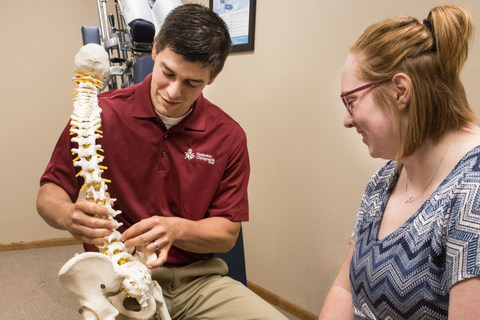
Young Entrepreneur Grows a Healthy Business in Small-Town Iowa
It’s no secret that rural Iowa has suffered through decades of population loss. The current trends are sobering, when you see data from the U.S. Census Bureau showing that two-thirds of Iowa counties (that’s 71 counties, including my home county of Calhoun County in west-central Iowa) lost population between 2010 and 2017, while 28 saw gains. So what would attract a young entrepreneur to an area like Calhoun County?
It’s a question I asked Dr. Jeff Redenius, who opened Redenius Chiropractic, PLC, in my hometown of Lake City (population 1,700) in 2016. Not only has this native son grown his customer base at his thriving chiropractic clinic, which is housed in the former variety store on Main Street, but perhaps the biggest surprise of all is the popularity of his attached 24-hour fitness center. So what’s the secret of this dynamic entrepreneur’s success? Here’s his story, which I shared in the 2018 Hometown Pride section of the Fort Dodge Messenger.
Back to Health:
Dr. Jeff Redenius Promotes Fitness, Wellness for All Ages
Jeff Redenius had enough to worry about as final exams loomed during his senior year at Central College in Pella. As he studied for his tests, however, the Lake City native suddenly felt like a knife was plunging into his chest.
“It was so intense I couldn’t take a deep breath,” said Redenius, 28, who owns Redenius Chiropractic, PLC, and a 24-hour fitness center in Lake City. “I went to a chiropractor and found out I had a rib out of place.”
A quick adjustment provided effective relief. Redenius learned that displaced ribs are fairly common and can be triggered by stress. “I typically see at least one patient each day with a displaced rib,” said Redenius, who opened his chiropractic clinic along Main Street in Lake City in August 2016.
Redenius’s own ordeal with pain prompted him to pursue a career in chiropractic care. “I was amazed at how much relief I experienced by going to the chiropractor,” he said. “I had known since high school that I wanted to go into health care, but this experience helped me clarify which area of health care to specialize in.”
Becoming a business owner
Redenius first discovered the value of high-quality health care close to home when he tore the anterior cruciate ligament (ACL) in his knee while playing football during his junior year of high school.
“I went to the hospital for physical therapy and began to appreciate all the medical care we have right here in Lake City,” said Redenius, who graduated from Southern Cal High School in Lake City in 2008.
After earning his bachelor of science degree in athletic training from Central College in in 2012, he wasn’t sure whether he wanted to pursue an advanced degree in physical therapy or chiropractic care. His displaced rib during final exams, along with his desire to own his own business, prompted his decision to enroll at the Palmer College of Chiropractic in Davenport.
“My dad, Gary, is a carpenter and has run his business for years, and I wanted to follow in his footsteps,” added Redenius, who had often worked with his father on construction projects through the years.

During Redenius’s years at Palmer, he served as the head athletic trainer and worked with the Palmer men’s and women’s rugby teams. After graduating from Palmer in February 2016, he and his wife, Jenny, a Hudson, Iowa, native, assessed their options about their next career moves.
The couple considered moving to Waverly, since it’s a growing community and a college town, but it proved more affordable for Redenius to open his chiropractic clinic in his hometown, especially when the local dime store on Main Street came up for sale.
“I knew a lot of people around here, which I figured would help grow my business faster,” Redenius said. “We also like the affordable cost of living and the chance to be close to family and raise our son, Sam, here.”
Fitness center proves popular
With approximately 5,500 square feet in the former dime store, the spacious building offered room for more than just a chiropractic clinic with exam rooms, a therapy room and an x-ray room. When Jenny suggested adding a fitness center, Redenius didn’t think it was feasible. “It was a great idea, but I was so overwhelmed by opening the chiropractic clinic that I didn’t think I could take on another project.”
Then Redenius found out that the Palmer College of Chiropractic was building a new fitness center and was willing to sell all the equipment from the former fitness center, including the free weights, the cable machines and the elliptical trainers, for a great deal. He rounded up some strong helpers, lined up a semi-truck and moved all the gym equipment to his building in Lake City.
After some remodeling, Redenius’s new 24-hour fitness center was ready for business. “We opened the fitness center in June 2016, a few months before I opened my chiropractic clinic in August that year,” Redenius said.
Some fitness center members like to take exercise classes and work with a personal trainer, while others like Mary Fern like to design their own workout routine. “I come here five to six days a week,” said Fern, 91, who moved to Lake City in August 2017. “It’s convenient, plus I like the variety.”
Fern walks laps in the gym, uses the cable machine to strengthen her arms and works out on the NuStep, which looks similar to an exercise bike and offers a safe, low-impact way to get a total-body workout. “Why do I exercise? If you don’t use it, you lose it,” she said.
Fern is a walking example of the power of healthy living, said Redenius, who features a quote from Thomas Edison on the wall of his reception area. “The doctor of the future will give no medication but will interest his patients in the care of the human frame, diet and in the cause and prevention of disease.”

Dr. Jeff Redenius promotes fitness for all ages. Mary Fern is 91 years young and follows a “use it or lose it” exercise and wellness philosophy.
“We’ve only started to make our mark”
While fitness and chiropractic care go hand in hand, along with massage therapy services provided at Redenius Chiropractic by therapist Haley Abbott, Redenius doesn’t hesitate to refer patients to other health-care providers, when necessary.
Redenius is also seeking new ways to promote healthy living, including a new weight-loss program he began offering this summer. The four-stage program includes a meal plan and weekly coaching to help patients reach a healthier weight. “You only have one body, and I’m more about preventing disease than fixing problems.”
That spirit of service also extends to Redenius’s hobbies and work in the community. In 2017, he purchased the Baptist Church complex in Lake City after the congregation joined with the Woodlawn Christian Church in Lake City. He has been remodeling the education wing into two apartments. One unit has been rented, and the other is available for rent.
“I like to build things and create positive change, from people’s health to my business to the local community,” Redenius said. “We’ve only started to make our mark.”
Want more?
Thanks for stopping by. I invite you to read more of my blog posts if you value intriguing Iowa stories and history, along with Iowa food, agriculture updates, recipes and tips to make you a better communicator.
If you like what you see and want to be notified when I post new stories, be sure to click on the “subscribe to blog updates/newsletter” button at the top of this page, or click here. Feel free to share this with friends and colleagues who might be interested, too.
Also, if you or someone you know could use my writing services (I’m not only Iowa’s storyteller, but a professionally-trained journalist with 20 years of experience), let’s talk. I work with businesses and organizations within Iowa and across the country to unleash the power of great storytelling to define their brand and connect with their audience through clear, compelling blog posts, articles, news releases, feature stories, newsletter articles, social media, video scripts, and photography. Learn more at www.darcymaulsby.com, or e-mail me at yettergirl@yahoo.com.
If you’re hungry for more stories of Iowa history, check out my top-selling “Culinary History of Iowa: Sweet Corn, Pork Tenderloins, Maid-Rites and More” book from The History Press. Also take a look at my latest book, “Dallas County,” and my Calhoun County” book from Arcadia Publishing. Both are filled with vintage photos and compelling stories that showcase he history of small-town and rural Iowa. Order your signed copies today! Iowa postcards are available in my online store, too.
Let’s stay in touch. I’m at darcy@darcymaulsby.com, and yettergirl@yahoo.com.
Talk to you soon!
Darcy
@Copyright 2018 Darcy Maulsby & Co. Blog posts may only be reprinted with permission from Darcy Maulsby.
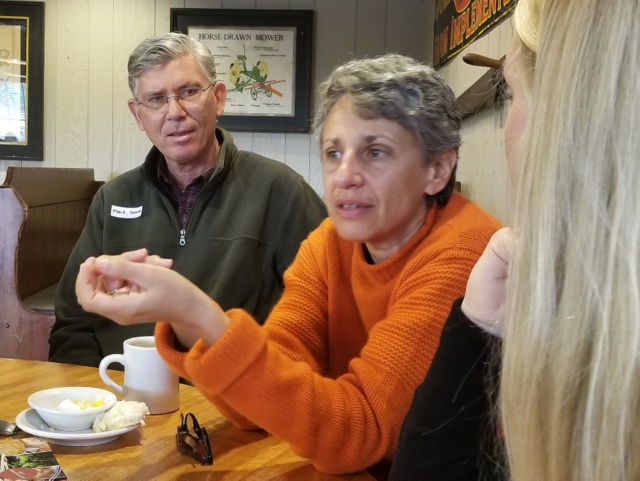
6 Steps for More Effective and Less Confrontational Conversations!
When was the last time you changed your mind? Not about something fairly inconsequential, like what to eat for supper tonight, but about a pivotal issue where you took a stand but later changed your mind?
Probably not lately. Maybe never.
It was an intriguing question posed by fellow writer Tamar Haspel–a question that still has me pondering its ramifications a few weeks after Haspel’s visit to Iowa.
“Many people go into conversations about food and agriculture with the expectations of changing others’ minds,” said Tamar Haspel, a Washington Post columnist who accepted the Iowa Food and Family Project’s invitation to tour Iowa farms in late September and learn more about Midwest agriculture. “We need to stop talking past each other.”

Tamar Haspel provided plenty of food for thought during her lecture about Iowa food and farming–and how to have more productive conversations about these topics–during a late September presentation at Drake University in Des Moines.
Yes, we need to stop talking past each other, I thought after Haspel uttered these sentiments during a breakfast meeting at the Iowa Machine Shed. It appeared that a lot of of the other ag leaders around the table with me were thinking the same thing.
If we believe we need to stop talking past each other, we need to understand more about how humans make decisions. Scottish philosopher and historian David Hume figured it out more than 200 years ago, Haspel noted, when he stated that reason is merely the “slave to the passions.”
“Why are we so bad at evaluating evidence?” asked Haspel, who is a Cape Cod oyster farmer and award-winning journalist who covers food supply issues, including biotech, pesticides, antibiotics, organics, nutrition and food policy.
Blame the confirmation bias, the human tendency to search for, interpret, favor and recall information that confirms one’s preexisting beliefs.
“Think about where the presets are on your car or truck radio,” said Haspel, who spoke at Drake University to approximately 50 people, including myself, on Sept. 27 during a public forum hosted by the Iowa Food and Family Project. “Think of the news sources you turn to and the people you follow on social media. All of us tend to live in our silo surrounded by people who think like us.”
How does all this play out with food and agriculture? Consider the facts. Farmers are mostly rural (no surprise) and Republican, based on campaign contributions reported to the Federal Election Commission. Activists and journalist are almost the exact opposite in these areas, Haspel said.
“This means farmers, activists and journalists are coming at food and agriculture issues with two completely different sets of values,” Haspel added.
6 steps for more effective conversations
This also means facts alone often aren’t persuasive. “So how do we communicate about food and farming? There are no good answers,” Haspel acknowledged.
Still, she offered six key steps to foster better communication, especially regarding food and agriculture topics:
1. Be persuaded that dynamics like the confirmation bias are real. While people often feel like they are rational human beings, everyone is susceptible to less-than-rational thinking. It’s time to re-evaluate the nature of certainty. “Are you right about everything?” Haspel asked the audience, who chuckled at the question. “So what aren’t you right about? It’s very difficult for us to spot where we go wrong, yet it’s easy to spot where others go wrong.” Two key questions keep Haspel awake at night as she strives to address her confirmation biases. “What do I get wrong? What am I not seeing? When you ask these questions, you go out into the world a little more circumspect,” she said.
2. Reconsider bias. Not only does everyone have biases, but bias is a necessary part of the human condition, Haspel said. “Expecting people to be objective is unfair.”
3. Drop “anti-science” from your vocabulary. “There’s science to say anything,” Haspel said. “When this plays out in the GMO debate, saying, ‘You’re anti-science’ translates as ‘you’re an idiot and I’m not.’”
4. Vet your sources. Assess the credibility of news sources, and seek various points of view. “I try to make sure my Twitter feed has lots of people I don’t agree with, along with people I agree with,” Haspel said.
5. Acknowledge truth on both sides. During her tour of Iowa farms, Haspel observed how many farmers feel beleaguered and lead with their defense. She also understands where this mindset comes from, as some audience members at Drake quizzed her about whether large-scale farming changes farmers’ motivations and turns agriculture into a profit-driven operation only. Other audience members questioned farmers’ commitment to protecting water quality and stressed the need for more regulation. “I talked with Iowa farmers who are definitely stewards of the land,” Haspel said. “But are there farmers who aren’t doing it right? Yes, there’s a minority for whom these criticisms apply. Since there is justice in some of the criticism, maybe that can help us find some common ground.”
6. Find intelligent people who disagree with you, and listen. “It’s so easy for us to talk to people who agree with us,” Haspel said. “I try to find the smartest person I know who doesn’t agree with me, and I listen carefully.”
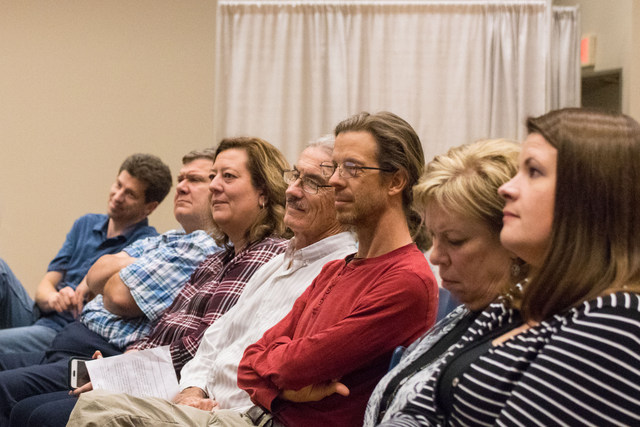
Audience members at Drake University in Des Moines, including Iowa Turkey Federation Executive Director Gretta Irwin (third from left) pondered Tamar Hapels’ 6 tips on more effective conversations involving food and ag topics.
Opening minds, acknowledging truth
I was fascinated by what I was hearing. I also wanted to talk this through with a colleague who attended Haspel’s lecture. I reached out to Gretta Irwin, a home economist and executive director of the Iowa Turkey Federation.
“Tamar opened our minds by helping us understand how we form opinions,” Irwin told me. “She also provided great examples of how we need to be open to thinking about questions, acknowledging truths on both sides, admitting where improvements can be made and learning more about the perspective of the opposing view.”
When questioned about modern agriculture, Haspel did a great job presenting both perspectives of the issue, Irwin added. “She clearly showed there’s no simple solution to issues facing agriculture.”
I also checked in with Sean McMahon, executive director of the Iowa Agriculture Water Alliance.
“Tamar’s comments that we can all be more introspective and work to better understand the other side’s perspectives resonated with me. Welcoming constructive dialogue, in the spirit of continuous improvement, can help further efforts.”
He also liked Haspel’s emphasis on storytelling, as did I. “Tamar’s advice that we should seek to influence through storytelling rather than through facts, figures, and science also struck a chord with me. By putting a human face on efforts and progress, we can reach more people with our story.”
Haspel encourages people to visit farms, have face-to-face conversations with farmers, try to see the benefits of all kinds of agriculture and find common ground, when possible. “If we can do nothing else, we can be kind,” Haspel said. “The common commitment to feeding people can also get us past the rhetoric.”
Want more?
Thanks for stopping by. I invite you to read more of my blog posts if you want more more intriguing Iowa stories and history, along with Iowa food, recipes and tips to make you a better communicator.
If you like what you see and want to be notified when I post new stories, be sure to click on the “subscribe to blog updates/newsletter” button at the top of this page. Feel free to share this information with friends and colleagues who might be interested, too.
If you’re hungry for more stories of Iowa history, check out my top-selling “Culinary History of Iowa: Sweet Corn, Pork Tenderloins, Maid-Rites and More” book from The History Press. Also take a look at my latest book, “Dallas County,” and my Calhoun County” book from Arcadia Publishing. Both are filled with vintage photos and compelling stories that showcase he history of small-town and rural Iowa. Order your signed copies today! Iowa postcards are available in my online store, too.
Let’s stay in touch. I’m at darcy@darcymaulsby.com, and yettergirl@yahoo.com.
Thanks,
Darcy
P.S. Thanks for joining me. I’m glad you’re here.
@Copyright 2017 Darcy Maulsby & Co.

6 Steps for More Effective and Less Confrontational Conversations
When was the last time you changed your mind? Not about something fairly inconsequential, like what to eat for supper tonight, but about a pivotal issue where you took a stand but later changed your mind?
Probably not lately. Maybe never.
It was an intriguing question posed by fellow writer Tamar Haspel–a question that still has me pondering its ramifications a few weeks after Haspel’s visit to Iowa.
“Many people go into conversations about food and agriculture with the expectations of changing others’ minds,” said Tamar Haspel, a Washington Post columnist who accepted the Iowa Food and Family Project’s invitation to tour Iowa farms in late September and learn more about Midwest agriculture. “We need to stop talking past each other.”

Tamar Haspel provided plenty of food for thought during her lecture about Iowa food and farming–and how to have more productive conversations about these topics–during a late September presentation at Drake University in Des Moines.
Yes, we need to stop talking past each other, I thought after Haspel uttered these sentiments during a breakfast meeting at the Iowa Machine Shed. It appeared that a lot of of the other ag leaders around the table with me were thinking the same thing.
If we believe we need to stop talking past each other, we need to understand more about how humans make decisions. Scottish philosopher and historian David Hume figured it out more than 200 years ago, Haspel noted, when he stated that reason is merely the “slave to the passions.”
“Why are we so bad at evaluating evidence?” asked Haspel, who is a Cape Cod oyster farmer and award-winning journalist who covers food supply issues, including biotech, pesticides, antibiotics, organics, nutrition and food policy.
Blame the confirmation bias, the human tendency to search for, interpret, favor and recall information that confirms one’s preexisting beliefs.
“Think about where the presets are on your car or truck radio,” said Haspel, who spoke at Drake University to approximately 50 people, including myself, on Sept. 27 during a public forum hosted by the Iowa Food and Family Project. “Think of the news sources you turn to and the people you follow on social media. All of us tend to live in our silo surrounded by people who think like us.”
How does all this play out with food and agriculture? Consider the facts. Farmers are mostly rural (no surprise) and Republican, based on campaign contributions reported to the Federal Election Commission. Activists and journalist are almost the exact opposite in these areas, Haspel said.
“This means farmers, activists and journalists are coming at food and agriculture issues with two completely different sets of values,” Haspel added.
6 steps for more effective conversations
This also means facts alone often aren’t persuasive. “So how do we communicate about food and farming? There are no good answers,” Haspel acknowledged.
Still, she offered six key steps to foster better communication, especially regarding food and agriculture topics:
1. Be persuaded that dynamics like the confirmation bias are real. While people often feel like they are rational human beings, everyone is susceptible to less-than-rational thinking. It’s time to re-evaluate the nature of certainty. “Are you right about everything?” Haspel asked the audience, who chuckled at the question. “So what aren’t you right about? It’s very difficult for us to spot where we go wrong, yet it’s easy to spot where others go wrong.” Two key questions keep Haspel awake at night as she strives to address her confirmation biases. “What do I get wrong? What am I not seeing? When you ask these questions, you go out into the world a little more circumspect,” she said.
2. Reconsider bias. Not only does everyone have biases, but bias is a necessary part of the human condition, Haspel said. “Expecting people to be objective is unfair.”
3. Drop “anti-science” from your vocabulary. “There’s science to say anything,” Haspel said. “When this plays out in the GMO debate, saying, ‘You’re anti-science’ translates as ‘you’re an idiot and I’m not.’”
4. Vet your sources. Assess the credibility of news sources, and seek various points of view. “I try to make sure my Twitter feed has lots of people I don’t agree with, along with people I agree with,” Haspel said.
5. Acknowledge truth on both sides. During her tour of Iowa farms, Haspel observed how many farmers feel beleaguered and lead with their defense. She also understands where this mindset comes from, as some audience members at Drake quizzed her about whether large-scale farming changes farmers’ motivations and turns agriculture into a profit-driven operation only. Other audience members questioned farmers’ commitment to protecting water quality and stressed the need for more regulation. “I talked with Iowa farmers who are definitely stewards of the land,” Haspel said. “But are there farmers who aren’t doing it right? Yes, there’s a minority for whom these criticisms apply. Since there is justice in some of the criticism, maybe that can help us find some common ground.”
6. Find intelligent people who disagree with you, and listen. “It’s so easy for us to talk to people who agree with us,” Haspel said. “I try to find the smartest person I know who doesn’t agree with me, and I listen carefully.”

Audience members at Drake University in Des Moines, including Iowa Turkey Federation Executive Director Gretta Irwin (third from left) pondered Tamar Hapels’ 6 tips on more effective conversations involving food and ag topics.
Opening minds, acknowledging truth
I was fascinated by what I was hearing. I also wanted to talk this through with a colleague who attended Haspel’s lecture. I reached out to Gretta Irwin, a home economist and executive director of the Iowa Turkey Federation.
“Tamar opened our minds by helping us understand how we form opinions,” Irwin told me. “She also provided great examples of how we need to be open to thinking about questions, acknowledging truths on both sides, admitting where improvements can be made and learning more about the perspective of the opposing view.”
When questioned about modern agriculture, Haspel did a great job presenting both perspectives of the issue, Irwin added. “She clearly showed there’s no simple solution to issues facing agriculture.”
I also checked in with Sean McMahon, executive director of the Iowa Agriculture Water Alliance.
“Tamar’s comments that we can all be more introspective and work to better understand the other side’s perspectives resonated with me. Welcoming constructive dialogue, in the spirit of continuous improvement, can help further efforts.”
He also liked Haspel’s emphasis on storytelling, as did I. “Tamar’s advice that we should seek to influence through storytelling rather than through facts, figures, and science also struck a chord with me. By putting a human face on efforts and progress, we can reach more people with our story.”
Haspel encourages people to visit farms, have face-to-face conversations with farmers, try to see the benefits of all kinds of agriculture and find common ground, when possible. “If we can do nothing else, we can be kind,” Haspel said. “The common commitment to feeding people can also get us past the rhetoric.”
Want more?
Thanks for stopping by. I invite you to read more of my blog posts if you want more more intriguing Iowa stories and history, along with Iowa food, recipes and tips to make you a better communicator.
If you like what you see and want to be notified when I post new stories, be sure to click on the “subscribe to blog updates/newsletter” button at the top of this page. Feel free to share this information with friends and colleagues who might be interested, too.
If you’re hungry for more stories of Iowa history, check out my top-selling “Culinary History of Iowa: Sweet Corn, Pork Tenderloins, Maid-Rites and More” book from The History Press. Also take a look at my latest book, “Dallas County,” and my Calhoun County” book from Arcadia Publishing. Both are filled with vintage photos and compelling stories that showcase he history of small-town and rural Iowa. Order your signed copies today! Iowa postcards are available in my online store, too.
Let’s stay in touch. I’m at darcy@darcymaulsby.com, and yettergirl@yahoo.com.
P.S. Thanks for joining me. I’m glad you’re here.
@Copyright 2017 Darcy Maulsby & Co.

Imagine That! Writers, Put Your Reader Right in the Action
“Picture this – you’re boarding a plane headed to an exotic or historic destination, like Rome or Dubai. You settle into your roomy business or first-class seat and the best part is, you didn’t have to pay for any of this. Sound too good to be true? Not if you were a United States Agency for International Development (USAID) employee between at least 2012-2014.”
Bet this hooked you, even if you’ve never heard of the USAID, right?
I knew nothing about the USAID, but I couldn’t resist scanning the e-mail when I read, “Picture this—you’re on a plane….” It put me right in the middle of the story, right from the start, and I wanted to know how the story ends.
That’s how you hook a reader, my friends. Craft your story so the audience sees themselves in it. It’s possible, even with a potentially dry, obscure topic.
Yes, even a press release can stir emotion
Would you be surprised to know this powerful writing example came from a press release issued by a politician from Iowa?
The release went on to detail documents revealing that “USAID employees have been purchasing business or first-class tickets for years, racking up nearly $3.1 million in taxpayer dollars on extravagant plane travel between 2012 and 2014.”
In the hands of less skilled writer, the title or lead of this news release could have been “Senator Questions USAID Deluxe Travel Expenses.” It would have been accurate, but boring. Most readers (myself included) probably have no idea what the USAID is. Game over, because we quit reading and move on. There’s nothing here of interest, right?
Think again.
Like millions of other Americans, I do care about wasteful spending of my tax dollars. I’m glad to know at least some of my elected officials are monitoring potential abuses of the system and are working to find solutions.
I won’t know this, however, if my elected officials aren’t communicating in a way that’s clear and compelling.
Now that I’ve pictured myself on settling in to a first-class seat on a plane bound for an exotic or historic destination—and I didn’t have to pay for any of this—I’m frustrated when I read that “one USAID employee took a $15,000 business-class trip, when the same trip would have only cost $3,000 if the employee had flown coach.”
This feeling of frustration isn’t something that lackluster writing provokes. Words that not only convey truth but stir emotion are a sign of a story well told.
Show, don’t tell
That’s the beauty of the “picture this” storytelling technique. It’s an effective way for authors, marketers and other writers to fulfill the age-old writing advice to “show, don’t tell.”
Sometimes I switch up the words a bit and lead with “Imagine this,” but the goal is still the same. Capture readers’ imaginations. Place them right in the center of the action. Motivate them to keep reading. It’s a powerful tool to that will propel you beyond the ranks of boring writers who fail to hold readers’ attention.
Imagine that!
What do you think?
Have you tried using the “picture this” or “imagine this” lead? Any other good tips for capturing your readers’ attention from the start? I welcome your comments and stories.
Want more?
Thanks for stopping by. I invite you to read more of my blog posts if you want more tips to make you a better communicator, along with intriguing Iowa stories, history and recipes. If you like what you see and want to be notified when I post new stories, be sure to click on the “subscribe to blog updates/newsletter” button at the top of this page. Let’s stay in touch. I’m at darcy@darcymaulsby.com.
P.S. Thanks for joining me. I’m glad you’re here.
@Copyright 2017 Darcy Maulsby & Co.
In the meantime, perhaps you’ll find value in my Top 10 Tips to Find the Right Writer to Tell Your Company’s Stories.
Top 10 Tips to Find the Right Writer to Tell Your Company’s Stories
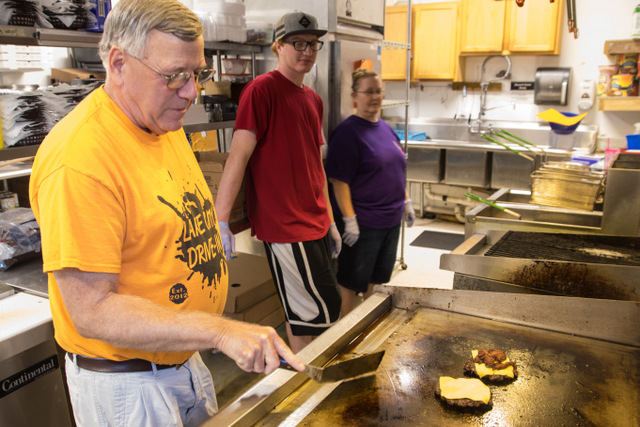
Iowa Beef Booster: Larry Irwin Takes a New Twist on Burgers
Make no mistake, the humble hamburger still reigns supreme from backyard barbecues to fast-food drive-ins across Iowa. But this Iowa icon also provides the perfect palette for culinary creativity when my friend Larry Irwin showcases his Burger of the Month flavors in my hometown of Lake City.
“I’m not doing anything fancy,” said Irwin, who has run the Lake City Drive-In since 2012. “I just like cooking down-home, comfort food.”
While it’s hard to beat a classic bacon cheeseburger, which remains one of the Lake City Drive-In’s top sellers, customers also love the monthly burger specials. Favorites include the Taco Burger (spiced with taco seasoning and chipotle and topped with nacho-cheese flavored chips), Darcy’s Meatloaf Burger, the Swiss Mushroom Burger, and the Ranch Burger (enhanced with homemade ranch dressing, pepper jack cheese and bacon).
“Burgers of all types are always our top sellers,” said Irwin, who serves more than 50 burgers a day, on average. “It’s fun to experiment with new flavors and feature them as the Burger of the Month.”
Top tips for unbeatable burgers
Interestingly, this adventurous spirit in the kitchen isn’t second nature for Irwin, who spent more than 30 years of his career in finance and banking. “I never did much cooking at home,” said Irwin, who grew up on a cattle and grain farm between Lohrville and Rockwell City. “I certainly never thought I’d run a restaurant.”
Irwin has found that offering new men

Larry Irwin shows off some tasty burgers from the Lake City Drive-In.
u items is one of the secrets to keep people coming back to the Lake City Drive-In. Inspiration for the Burger of the Month comes from a variety of sources.
“Sometimes our customers suggest ideas,” Irwin said. “A lot of the Burger of the Month ideas come from my son, Chris, who is an agronomist in northeast Iowa. He travels a lot for his job and tells me about burger flavors he discovers in various cafes.”
While unique flavors are part of the fun, a great burger starts with the basics, said Irwin, who shares the following tips:
• Select an 80/20 ground beef for the best flavor. Irwin always uses fresh beef, never frozen patties, to make his 1/3 pound burgers.
• Preheat the grill before you place the hamburger patties on the grill.
• Cook the hamburger patties over medium heat. If the temperature is too high, it’s easy to burn the outside of the burger and leave the inside undercooked, said Irwin, who cooks his burgers for about five minutes on each side.
• Season the patties on the grill. Irwin sprinkles a mix of garlic powder, onion powder, Lawry’s seasoning salt, table salt, white sugar and black pepper on both sides of each hamburger patty as the meat cooks.
• Don’t forget to butter and toast the bun before serving the burger.
Time-saving systems in the kitchen are also invaluable. Since the Lake City Drive-In is located on Main Street across from South Central Calhoun High School, things can get hectic when hungry crowds stop by, especially during volleyball tournaments and home football games. Irwin plans ahead on these days and cooks each hamburger patty for two minutes per side before placing the partially-cooked patties in a warm slow cooker. When the crowds arrive, it only takes a couple more minutes of grilling time before the burgers are ready.
This strategy also pays off during planting and harvest, when the drive through becomes one of the busiest places at the Lake City Drive-In. “You can always tell when an order is going out to farmers, because there are at least five or six cheeseburgers in there,” said Irwin, who farmed at one point in his career.
Keeping things simple while adding a little variety is the key to a great burger, Irwin added. “I love the flavor of beef. If I could only have one meat for the rest of my life, I’d choose hamburger, because I can make anything out of it.”
Hungry for more? Check out my blog post and Farm News column “Get Your Grill On: How to Build a Better Burger.”

Darcy’s Meatloaf Burger
Darcy’s Meatloaf Burgers
Larry Irwin will be featuring these Meatloaf Burgers, made from my recipe, as the Burger of the Month in June 2017.
2 pounds ground beef
1 1 / 2 to 2 cups herb-seasoned stuffing mix (experiment to find what amount helps the burger patties stick together the best)
1 onion, chopped
1 teaspoon seasoning salt
1/4 teaspoon freshly-ground pepper
1 teaspoon garlic powder
2 large eggs, lightly beaten
1 /4 cup milk
2 tablespoons barbecue sauce
1 / 4 cup ketchup
2 tablespoons brown sugar
1 teaspoon dry mustard
Combine ground beef, stuffing mix, onion, salt, pepper and garlic powder. In a separate bowl, beat eggs, milk, and barbecue sauce. Combine barbecue sauce mixture with meat mixture.
In a separate bowl, combine ketchup, brown sugar and dry mustard. This mixture can either be spread as a glaze while the burgers are cooking on the grill, or the glaze can be mixed into the burger patty mixture before the burgers are grilled.
Shape beef mixture into patties. Grill over medium heat to desired doneness. If using the ketchup mixture as a glaze, spread over the top of each burger during the final minutes of cooking on the grill.
Ranch Dressing
While this makes restaurant-sized quantities, scale down the recipe for home use.
1 gallon regular mayonnaise
1 / 2 gallon buttermilk
2 packages (3.2 ounces each) powdered ranch dressing mix
Combine all ingredients and stir with an electric mixer. Refrigerate.
Boom Boom Sauce
This spicy sauce has a kick and tastes great on burgers and salads.
4 cups Thousand Island dressing
3 / 4 cup buffalo hot sauce
1 / 4 cup red pepper flakes
Combine dressing, buffalo sauce and red pepper flakes; refrigerate.
Sloppy Joes
1 pound hamburger
1 can chicken gumbo soup
Ketchup and mustard, to taste
Brown sugar, to taste
Salt and pepper, to taste
Brown the hamburger; drain. Add soup and season with ketchup, mustard, brown sugar, salt and pepper until the desired flavor is achieved.

This story first ran on Farm News, May 2017.
Want more Iowa culture and history?
Read more of my blog posts if you want more Iowa stories, history and recipes, as well as tips to make you a better communicator.
If you’re hungry for more stories of Iowa history, Larry is kind enough to carry my books at the Lake City Drive-In. You can also check out my top-selling “Culinary History of Iowa: Sweet Corn, Pork Tenderloins, Maid-Rites and More” book from The History Press, as well as my Calhoun County” book from Arcadia Publishing, which showcases the history of small-town and rural Iowa. Order your signed copies today! Iowa postcards are available in my online store, too.
P.S. Thanks for joining me. I’m glad you’re here.
@Copyright 2017 Darcy Maulsby & Co.

Learning from the Land: 9 Surprising Ways Farmers Make Conservation a Priority
Spring planting will soon arrive here in Iowa, but planting our Calhoun County fields isn’t the only thing on my mind. My family is always looking for ways to embrace conservation and better manage our land, because we understand the benefits of improved water quality and soil sustainability extend far beyond our fields.
This mindset defines any true steward of the land, and Iowa is blessed with an abundance of conservation-minded farmers. This is reflected in the Iowa Environmental Leader Award, which recognizes the exemplary voluntary efforts of Iowa’s farmers who are committed to healthy soils and improved water quality.
We were honored to receive a 2016 Iowa Environmental Leader Award last August at the Iowa State Fair from Iowa’s governor, lieutenant governor, Iowa Department of Agriculture and Land Stewardship staff and Iowa Department of Natural Resources staff. It was inspiring to see how many other progressive, dedicated farm families across Iowa are redefining the sustainable nature of modern agriculture.
Learning from the land is just part of my DNA. My great-great grandfather, John Dougherty, emigrated from Ireland and settled in Calhoun County north of Lake City in 1889. He purchased 200 acres, and history records that he “placed the land under a high state of cultivation,” a legacy my family carries on today with our Century Farm.
I’m also guided by the philosophy of another Iowan, Aldo Leopold, whose “land ethic” called for a principled, caring relationship with nature. “When we see land as a community to which we belong, we may begin to use it with love and respect,” noted Leopold, author of the Sand County Almanac.

The residue of the previous year’s crop helps hold our precious soil in place and builds organic matter in the soil.
Here are 9 ways that Iowa farm families like mine are putting this land ethic into practice:
1. Building on a legacy of conservation. Iowa agriculture reflects a long history of people helping the land. The process accelerated in 1935, when the Soil Conservation Service was created in the U.S. Department of Agriculture. In this era, young men with the Civilian Conservation Corps (CCC) worked on hundreds of Iowa farms to assist with soil-erosion-control projects, such as terracing hills, digging ponds, repairing gullies and planting trees for wind breaks. In 1948, more than 100,000 farmers from across the Midwest flocked to the National Soil Conservation Field Days in Dexter, Iowa, to learn new conservation practices. Even President Harry Truman made an appearance see farmers’ conservation efforts first-hand. (You can read more about it in my blog post “Riding with Harry,” where I interviewed a young Iowan who escorted Truman on a bulldozer in the fields.) While much has changed in farming since the 1930s and 1940s, one thing endures—our commitment to be good stewards of the land and keep our land productive for generations to come.
2. Prioritizing soil health. I’m convinced that unlocking the secrets of the soil is the next frontier in farming. As world population and food production demands rise, keeping our soil healthy and productive is of paramount importance. By using cover crops, diverse rotations and other systems, more Iowa farmers are increasing their soil’s organic matter while improving microbial activity. As a result, farmers are increasing water infiltration, controlling runoff and enhancing soil health—all while harvesting better yield and profit potential.
3. Balancing the three-legged stool of sustainability. Successful farm management involves environmental sustainability, economic sustainability and social sustainability that benefits not only our farm, but our community, state and beyond. Without all of those three legs, the sustainability stool falls down. That’s why my family has invested in a number of best-management practices, including soil testing to better manage fertilizer applications, grassed waterways and grassed field borders to help control soil erosion, conservation tillage, drainage water management, and the addition of windbreaks and shelterbelts. These practices help improve soil health, prevent erosion, boost yield potential and keep nutrients in place where they can nourish our crop and protect Iowa’s water quality.
4. Learning from others. I’m blessed to live in the epicenter of agriculture, where farmers have a strong support network to help enhance their conservation and farm management strategies. I value input from Iowa State University Extension, Iowa Farm Bureau Federation, Iowa Soybean Association, Iowa Corn Growers Association, MaxYield Cooperative’s SciMax Solutions, Natural Resources Conservation Service, Practical Farmers of Iowa and other trusted organizations. In my roles as a freelance ag journalist and president of the Calhoun County Farm Bureau and Calhoun County Corn Growers, I enjoy meeting with other conservation-minded farmers across the state who are willing to question current management practices and never stop asking, “Is there a better way?”
5. Finding conservation-minded urban partners. As Iowans, we’re all in this together when it comes to conservation. I applaud the City of Storm Lake for its city-wide plan emphasizing green infrastructure practices. These practices include bioreactors, which essentially function like large “coffee filters” to help improve water quality. The results are impressive. City manager Jim Patrick tells me that Storm Lake has seen a bioreactor remove 45 percent of the nitrates coming off agricultural land in the area. Storm Lake has also hosted “reverse field days” so farmers, soil and water conservation groups and others can see the progress that’s being made. “These partnerships are vital, because rural and urban communities are in this together,” Patrick told me. “It’s not city water or ag water; it’s all our water.”
6. Focusing on continuous improvement. A spirit of continuous improvement contributes to long-term success in any business, including our farm. My dad, Jim Dougherty, served as a township committee member with the Agricultural Stabilization and Conservation Service, the forerunner of USDA’s Natural Resources Conservation Service. Dad was also quick to see the value of conservation tillage and other practices that make the farm productive and sustainable. Today, we are using precision ag tools to maximize production and conservation. We never stop seeking solutions.
7. Developing a conservation philosophy. If you never try something different, how do you know if you’re maximizing your investment on every acre? My conservation philosophy is to keep learning, help my family do our best to protect Iowa’s precious soil and water resources, and pass on a legacy of conservation to future generations.
8. Providing leadership. We’ve hosted numerous media professionals at our farm, from the local newspaper to USA Today and “Market to Market,” to share what we’re doing to promote conservation and protect soil and water quality. In 2015, I also worked with the Iowa Food and Family Project to coordinate and host Expedition Yetter, a bus tour of farms in west-central Iowa that allowed urban Iowans to see conservation in action. (Watch “Market to Market’s” Expedition Yetter and water quality video here.) That same year, I also testified before the U.S. Senate Small Business Committee in Washington, D.C. to explain to federal lawmakers how conservation plays a key role on my family’s farm.
9. Enjoying the journey. Enhanced conservation, like improved farm management, is a quest that never ends. I value the legacy of farmland that was passed on to my family from previous generations and enjoy the challenge of maximizing our acres. With all the technology available today, it’s exciting to see what’s next as we keep learning from the land to enhance the sustainable nature of modern agriculture.
Darcy Dougherty Maulsby is a proud member of a Century Farm family, author, entrepreneur, business owner, and farm leader from Lake City. Visit her online at www.darcymaulsby.com.
* This editorial first appeared in the April 9, 2017, Sunday edition of the Fort Dodge Messenger.
P.S. Thanks for joining me. I’m glad you’re here.
@Copyright 2017 Darcy Maulsby & Co.
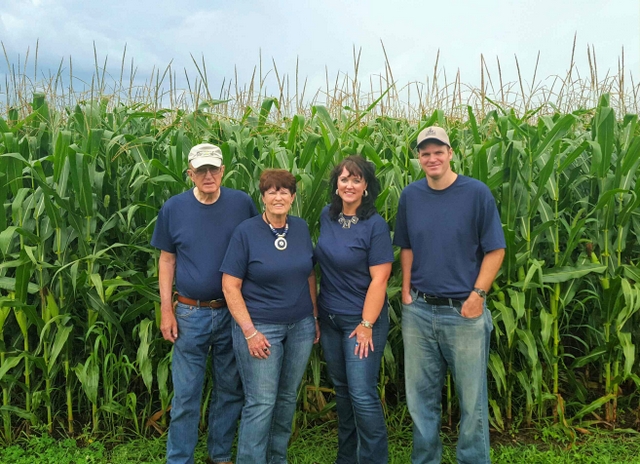
My family (including my dad, Jim, my mom, Jan, me and my younger brother, Jason, on our Calhoun County Century Farm.

The “No BS” Way to Protect Yourself from Rude, Obnoxious People
Ever get a nasty email or comment from a co-worker, client, or other acquaintance? You know you shouldn’t let it bother you, but it does.
It’s called being human. It happened to me recently when someone told me my writing is impersonal and I need to work on learning how to tell a story. (Kind of ironic to chastise a published author, but hey, crap happens.)
When you’re verbally attacked, here are some “No BS” ways to handle it from this Iowa farm girl, who knows a thing or two about BS:
1. Stay calm, and try to uncover any miscommunication. While a rude person makes you want to dish it right back to them, don’t respond with the first rebuttal that pops into your mind. Remember that sometimes rude comments stem from simple misunderstandings. If that’s the case, take a deep breath, ask questions and try to clear up the miscommunication. (This situation still isn’t an excuse for rudeness, but don’t succumb to the temptation to be rude in return.)
2. Don’t feed the trolls. When you’re attacked online, don’t take the bait. Trolls deliberately post inflammatory comments and start arguments to provoke, disrupt and upset others. Trolls love to create conflict for their own amusement. Don’t reward this bad behavior. Just ignore the trolls’ taunts.
3. Avoid the word “you.” If you’re dealing with a rude person who is not a troll, you don’t have to put up with his or her verbal abuse. Stand your ground. I say, “I don’t accept what I’m hearing, and I don’t deserve to be treated like this.” Notice I didn’t say “you.” Using that word in this case often escalates this situation, because “you” tends to make the other person feel attacked. When a person feels threatened, they often quit listening and get ready to fight.
4. Fire the person. If you have the choice to “fire” a rude person (such as an obnoxious client), do it. Life is too short to waste time with people like this. I usually say, “I really appreciate that you came to me with your marketing needs. I work hard to listen to you and share my writing skills to help you reach your business goals. It looks like we’re just not a good fit, though. Feel free to find someone else who’s better suited to you, and I wish you well.” If you can’t fire the rude person, try to minimize your time around him or her. If this person is negatively affecting your productivity and/or mental health, it’s worth it to remove him or her as much as possible from your life.
5. Be grateful. That’s right—be grateful. Once you’ve gotten immersed in a bad situation with an obnoxious person, start noticing how you interact with friends, family members, clients or colleagues who are pleasant to be around. Makes you pretty darn grateful for all the good, uplifting people in your life, right?
Do you have any “No BS” ways you deal with rude, obnoxious people? I’d love to hear your suggestions.
P.S. Thanks for joining me. I’m glad you’re here.
@Copyright 2017 Darcy Maulsby & Co.
